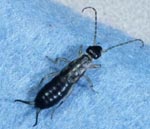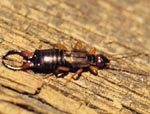Earwig
Description

Figure 1. Earwig
The name earwig comes from a superstition that the insects would enter the ears of a sleeping person and tunnel into the brain. Fortunately, this is not true. Earwigs are not a major pest; however they do feed on flowers and can be a nuisance inside homes. Unusually wet springs and summers tend to intensify earwig infestations. There are approximately 22 species of earwigs in the USA. The major earwig species in the northern region of the USA is the European earwig, Forficula auriculari.

Figure 2. Earwig Nymph
Adults are pale-brown to reddish-black in color. They are 1/4 to 1.0 inches long and the body appears flattened. The front wings are short and meet in a straight-line down the back. The hind wings are membranous and folded underneath the front wings. Both the males and females have large, pincers (cerci) that stick out from the back of the abdomen. The pincers are used in defense for protection against predators or to capture prey. Earwigs resemble rove beetles, but rove beetles do not have cerci.
Life Cycle
Earwigs hibernate in the soil as adults during the winter. In spring, adult females lay 30 to 55 eggs in the soil. The females nurture and protect the eggs and young (maternal care), which is uncommon for insects. The eggs hatch into young nymphs. Earwigs have four to five nymphal stages before becoming adults. Earwigs are nocturnal, hiding during the daytime and active at night. They tend to prefer moist environments. During the day, they usually inhabit dark confined or shaded areas such as underneath plants, debris, stones, organic mulch, tree bark, and flower pots. They are less likely to be found in exposed sunny areas.
Damage

Figure 3. Earwig Adult
Earwigs will enter homes to hide, but they don't breed because the eggs and nymphs cannot tolerate long periods of dryness (low humidity). When inside homes, earwigs may be mistaken for cockroaches, as they tend to resemble each other when it is dark. They generally occur in groups and once inside a home they will feed on crumbs of human food as well as cat and dog food. Earwigs are attracted to outdoor lighting.
Earwigs feed on a wide range of food sources. They will eat aphids, mites, and insect eggs. However, they also feed on the flowers of plants including marigolds, petunias, dahlias, and hostas. Earwigs will eat small holes in plant leaves and flowers during the night. Leaves and petals have a ragged appearance with irregular-shaped holes. Seedlings and flowering plants can be severely damaged or killed by high earwig populations. Earwigs also eat pollen, fungi, and lichens.
Management
Earwig management includes sanitation, modification of cultural practices, trapping, or the use of pest control materials. Remove outdoor harborage such as firewood, plant debris, weeds, and organic mulches from around the foundation of a house or building. This, along with caulking foundation cracks and crevices, will minimize entry into homes. Avoid overwatering plants and don't use thick organic mulches. Inorganic mulches such as lava rock or stone are less attractive to earwigs. A moistened rolled-up newspaper, old tuna fish can, or an eight to ten inch section of garden hose can be used to trap earwigs. Place traps in shaded areas where earwigs are most likely to hide during the daytime. Check traps in the morning and shake the insects into a pail of soapy water. Granular or wettable powder formulations of insecticides may be used to control earwigs outdoors. Do not apply insecticides directly onto flowers, especially those that are toxic to bees. For best results, apply insecticides late in the afternoon or early evening, when earwigs are active. To prevent earwigs from entering homes, caulk cracks and crevices and weather-strip doors. Earwigs that accidentally invade home are primarily a nuisance because they don't cause damage or reproduce. Sweep or vacuum up earwigs that do enter the home. Chemical treatments inside the home are generally not necessary.
Prepared by Raymond A. Cloyd, Department of Natural Resources and Environmental Sciences, University of Illinois, Urbana, Illinois, in cooperation with the Illinois Natural History Survey. For additional copies, contact your local University of Illinois Extension Office.